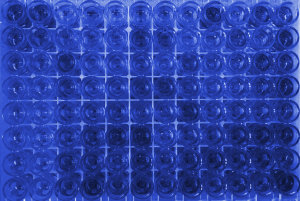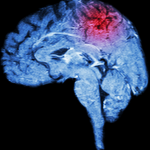 We design and lead clinical trials with a goal to bring new treatments to stroke patients. Although the underlying science must be rigorous and sound, collaboration and communication are critical to translating that science into new treatments to patients. Work in our laboratory seeks to understand how a pharmacologic intervention is linked to the hypothesized mechanism of action in patients. Frequently, there are subtle but important differences between model organisms and patients that can have significant implications for optimal trial design. In this regard, biomarkers and intermediate endpoints can assist interpretation of early phase clinical trial results and inform subsequent development.
We design and lead clinical trials with a goal to bring new treatments to stroke patients. Although the underlying science must be rigorous and sound, collaboration and communication are critical to translating that science into new treatments to patients. Work in our laboratory seeks to understand how a pharmacologic intervention is linked to the hypothesized mechanism of action in patients. Frequently, there are subtle but important differences between model organisms and patients that can have significant implications for optimal trial design. In this regard, biomarkers and intermediate endpoints can assist interpretation of early phase clinical trial results and inform subsequent development.
Below are some examples of our clinical trial projects.

The starting point for many of our studies arises from the analysis of samples and data from patients. Developing and applying several different tools, including neuroimaging analysis, metabolomics and proteomics, we seek to identify biomarkers of neurological disease. Promising candidates may become diagnostic or prognostic biomarkers. However, our primary goal is to leverage biomarkers to study the biological and pathological events following acute stroke. In this regard, our biomarker studies guide our subsequent hypotheses about mechanisms of secondary brain injury.
Below are some examples of our work on biomarker development.
 Our patient-oriented investigation is the starting point for our research. Through metabolomic and proteomic screens, we identify candidate markers for secondary brain injury. Leading candidates that are independently associated with outcome and tightly linked to secondary brain injury are selected for further study. In order to determine whether there is a causal link between the biomarker and brain injury, we use rodent stroke and cell models to elucidate underlying mechanisms. Our work relies on a robust foundation of fundamental research conducted in other laboratories that study basic mechanisms of biology. From this perspective, our research has a translational focus, attempting to link basic biology to clinically relevant pathophysiology.
Our patient-oriented investigation is the starting point for our research. Through metabolomic and proteomic screens, we identify candidate markers for secondary brain injury. Leading candidates that are independently associated with outcome and tightly linked to secondary brain injury are selected for further study. In order to determine whether there is a causal link between the biomarker and brain injury, we use rodent stroke and cell models to elucidate underlying mechanisms. Our work relies on a robust foundation of fundamental research conducted in other laboratories that study basic mechanisms of biology. From this perspective, our research has a translational focus, attempting to link basic biology to clinically relevant pathophysiology.
Below are some examples of our work investigating candidate mechanisms of secondary brain injury.
 What pathological processes contribute to the severity of brain injury and the degree of recovery after an acute stroke? By characterizing the pathophysiological processes that are linked to clinical recovery, we attempt to delineate which injury mechanisms have a substantive impact on patients’ lives. We focus on secondary brain injury, which includes the study of brain edema, hemorrhagic transformation and the interrelationships with post-stroke inflammation. We develop neuroimaging tools to characterize these maladaptive events, which in turn, can serve as the link to discovering underlying candidate pathways.
What pathological processes contribute to the severity of brain injury and the degree of recovery after an acute stroke? By characterizing the pathophysiological processes that are linked to clinical recovery, we attempt to delineate which injury mechanisms have a substantive impact on patients’ lives. We focus on secondary brain injury, which includes the study of brain edema, hemorrhagic transformation and the interrelationships with post-stroke inflammation. We develop neuroimaging tools to characterize these maladaptive events, which in turn, can serve as the link to discovering underlying candidate pathways.
Below are some examples of our work focusing on pathophysiology of secondary brain injury.
 We design and lead clinical trials with a goal to bring new treatments to stroke patients. Although the underlying science must be rigorous and sound, collaboration and communication are critical to translating that science into new treatments to patients. Work in our laboratory seeks to understand how a pharmacologic intervention is linked to the hypothesized mechanism of action in patients. Frequently, there are subtle but important differences between model organisms and patients that can have significant implications for optimal trial design. In this regard, biomarkers and intermediate endpoints can assist interpretation of early phase clinical trial results and inform subsequent development.
We design and lead clinical trials with a goal to bring new treatments to stroke patients. Although the underlying science must be rigorous and sound, collaboration and communication are critical to translating that science into new treatments to patients. Work in our laboratory seeks to understand how a pharmacologic intervention is linked to the hypothesized mechanism of action in patients. Frequently, there are subtle but important differences between model organisms and patients that can have significant implications for optimal trial design. In this regard, biomarkers and intermediate endpoints can assist interpretation of early phase clinical trial results and inform subsequent development. 

 Our patient-oriented investigation is the starting point for our research. Through metabolomic and proteomic screens, we identify candidate markers for secondary brain injury. Leading candidates that are independently associated with outcome and tightly linked to secondary brain injury are selected for further study. In order to determine whether there is a causal link between the biomarker and brain injury, we use rodent stroke and cell models to elucidate underlying mechanisms. Our work relies on a robust foundation of fundamental research conducted in other laboratories that study basic mechanisms of biology. From this perspective, our research has a translational focus, attempting to link basic biology to clinically relevant pathophysiology.
Our patient-oriented investigation is the starting point for our research. Through metabolomic and proteomic screens, we identify candidate markers for secondary brain injury. Leading candidates that are independently associated with outcome and tightly linked to secondary brain injury are selected for further study. In order to determine whether there is a causal link between the biomarker and brain injury, we use rodent stroke and cell models to elucidate underlying mechanisms. Our work relies on a robust foundation of fundamental research conducted in other laboratories that study basic mechanisms of biology. From this perspective, our research has a translational focus, attempting to link basic biology to clinically relevant pathophysiology. What pathological processes contribute to the severity of brain injury and the degree of recovery after an acute stroke? By characterizing the pathophysiological processes that are linked to clinical recovery, we attempt to delineate which injury mechanisms have a substantive impact on patients’ lives. We focus on secondary brain injury, which includes the study of brain edema, hemorrhagic transformation and the interrelationships with post-stroke inflammation. We develop neuroimaging tools to characterize these maladaptive events, which in turn, can serve as the link to discovering underlying candidate pathways.
What pathological processes contribute to the severity of brain injury and the degree of recovery after an acute stroke? By characterizing the pathophysiological processes that are linked to clinical recovery, we attempt to delineate which injury mechanisms have a substantive impact on patients’ lives. We focus on secondary brain injury, which includes the study of brain edema, hemorrhagic transformation and the interrelationships with post-stroke inflammation. We develop neuroimaging tools to characterize these maladaptive events, which in turn, can serve as the link to discovering underlying candidate pathways.

